tow Citroen C5 2017 (RD/TD) / 2.G Owner's Guide
[x] Cancel search | Manufacturer: CITROEN, Model Year: 2017, Model line: C5, Model: Citroen C5 2017 (RD/TD) / 2.GPages: 348, PDF Size: 10.72 MB
Page 176 of 348

174
C5_en_Chap07_info-pratiques_ed01-2016
TOTAL & CITROËN
Partners in performance and
protecting the environment
Innovation in the search for
performance
For over 40 years, the TOTAL Research and
Development departments have developed
lubricants for CITROËN, to match the latest
technical innovations on CITROËN vehicles, both for
competition and for everyday motoring.
For you, this is an assurance that you will obtain the
best per formance from your engine.
Optimum protection for your
engine
By having your CITROËN vehicle
serviced with TOTAL lubricants, you are
contributing towards improving the life
and per formance of your engine, while
also protecting the environment.
Practical information
Page 182 of 348
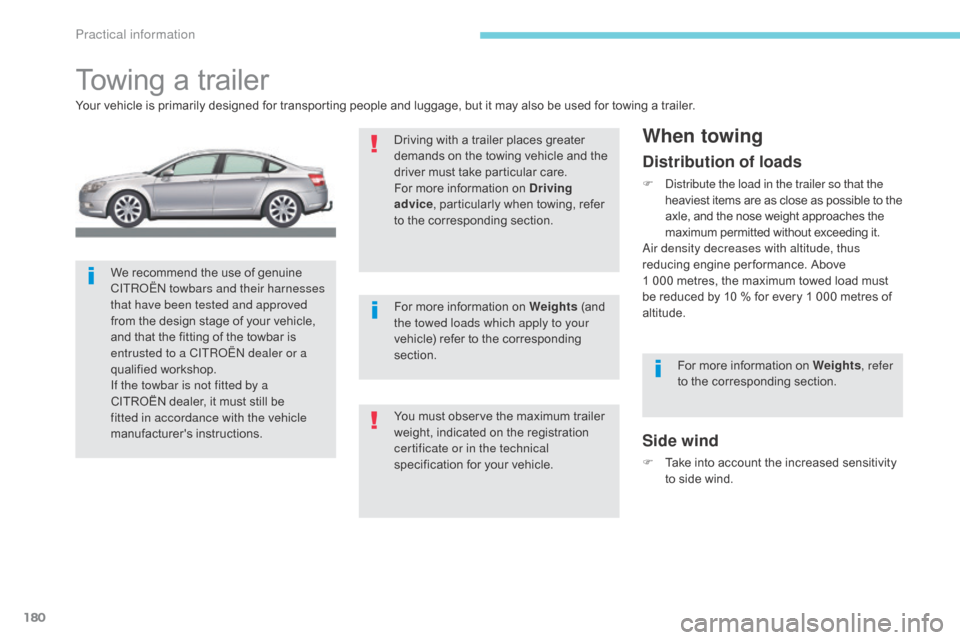
180
C5_en_Chap07_info-pratiques_ed01-2016
Towing a trailer
Your vehicle is primarily designed for transporting people and luggage, but it may also be used for towing a trailer.
Side wind
F Take into account the increased sensitivity to side wind.
When towing
We recommend the use of genuine
CITROËN towbars and their harnesses
that have been tested and approved
from the design stage of your vehicle,
and that the fitting of the towbar is
entrusted to a CITROËN dealer or a
qualified workshop.
If the towbar is not fitted by a
CITROËN dealer, it must still be
fitted in accordance with the vehicle
manufacturer's instructions.
Distribution of loads
F Distribute the load in the trailer so that the heaviest items are as close as possible to the
axle, and the nose weight approaches the
maximum permitted without exceeding it.
Air density decreases with altitude, thus
reducing engine per formance. Above
1
000 metres, the maximum towed load must
be reduced by 10
% for every 1 000 metres of
altitude.
For more information on Weights , refer
to the corresponding section.
Driving with a trailer places greater
demands on the towing vehicle and the
driver must take particular care.
For more information on Driving
advice
, particularly when towing, refer
to the corresponding section.
You must observe the maximum trailer
weight, indicated on the registration
certificate or in the technical
specification for your vehicle. For more information on Weights (and
the towed loads which apply to your
vehicle) refer to the corresponding
section.
Practical information
Page 183 of 348
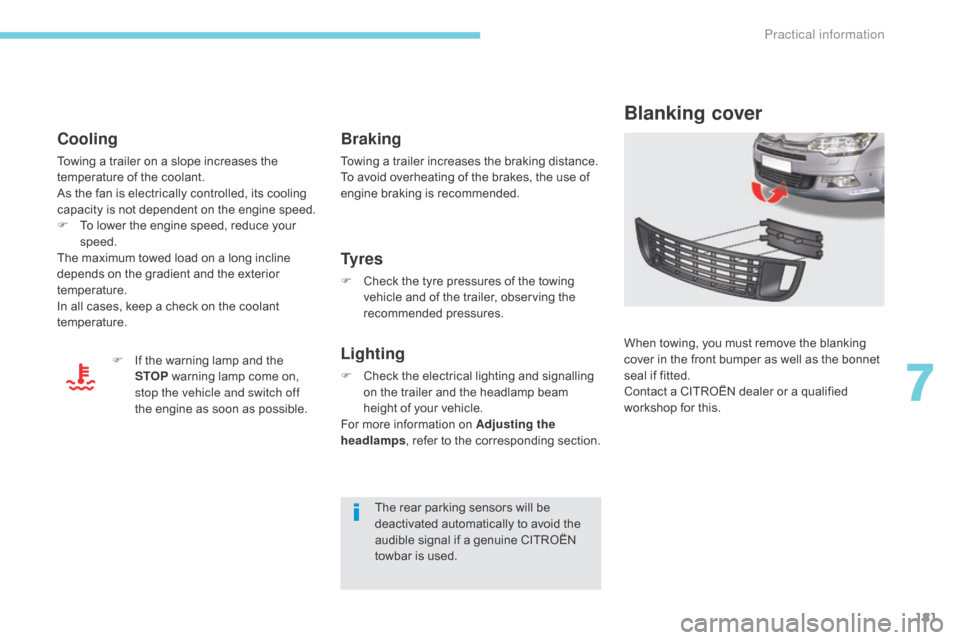
181
C5_en_Chap07_info-pratiques_ed01-2016
Blanking cover
When towing, you must remove the blanking
cover in the front bumper as well as the bonnet
seal if fitted.
Contact a CITROËN dealer or a qualified
workshop for this.
Ty r e s
F Check the tyre pressures of the towing vehicle and of the trailer, observing the
recommended pressures.
Lighting
F Check the electrical lighting and signalling on the trailer and the headlamp beam
height of your vehicle.
For more information on Adjusting the
headlamps , refer to the corresponding section.
The rear parking sensors will be
deactivated automatically to avoid the
audible signal if a genuine CITROËN
towbar is used.
Braking
Towing a trailer increases the braking distance.
To avoid overheating of the brakes, the use of
engine braking is recommended.
Cooling
Towing a trailer on a slope increases the
temperature of the coolant.
As the fan is electrically controlled, its cooling
capacity is not dependent on the engine speed.
F
T
o lower the engine speed, reduce your
speed.
The maximum towed load on a long incline
depends on the gradient and the exterior
temperature.
In all cases, keep a check on the coolant
temperature.
F
I
f the warning lamp and the
STOP warning lamp come on,
stop the vehicle and switch off
the engine as soon as possible.
7
Practical information
Page 186 of 348
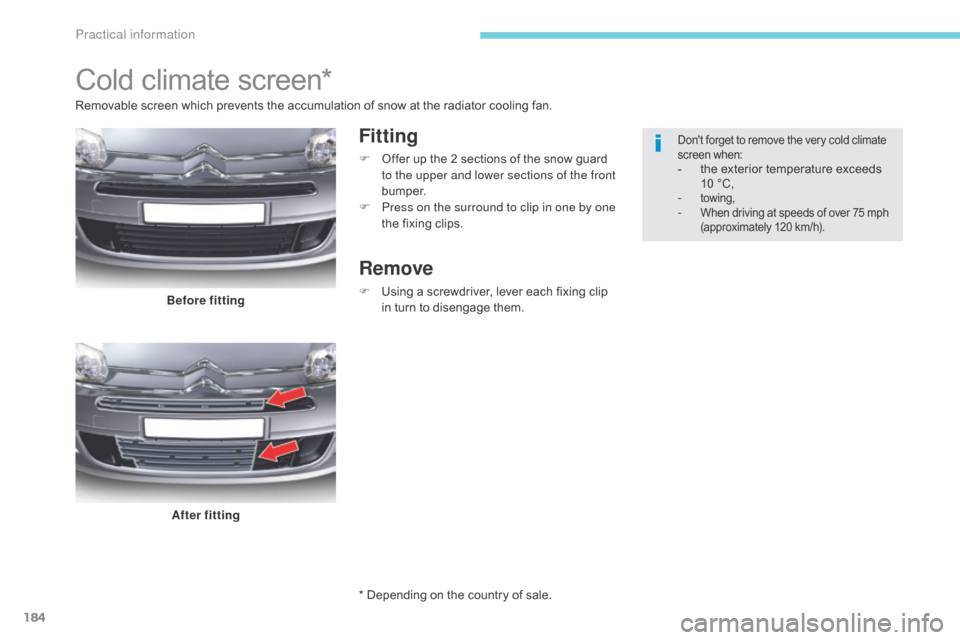
184
C5_en_Chap07_info-pratiques_ed01-2016
Cold climate screen*
Fitting
F Offer up the 2 sections of the snow guard to the upper and lower sections of the front
b u m p e r.
F
P
ress on the surround to clip in one by one
the fixing clips.
Remove
F Using a screwdriver, lever each fixing clip in turn to disengage them.
Before fitting
After fitting
Don't forget to remove the very cold climate
screen when:
- the exterior temperature exceeds 10 °C,
-
towing,- When driving at speeds of over 75 mph (approximately 120 km/h).
Removable screen which prevents the accumulation of snow at the radiator cooling fan.
* Depending on the country of sale.
Practical information
Page 196 of 348
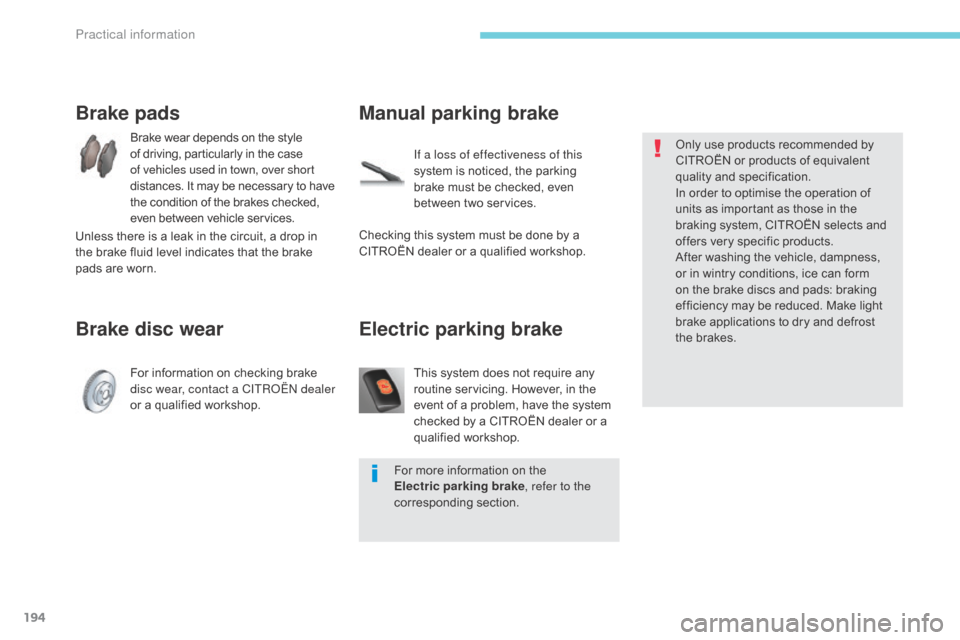
194
C5_en_Chap07_info-pratiques_ed01-2016
Brake pads
Brake wear depends on the style
of driving, particularly in the case
of vehicles used in town, over short
distances. It may be necessary to have
the condition of the brakes checked,
even between vehicle services.
Brake disc wear
For information on checking brake
disc wear, contact a CITROËN dealer
or a qualified workshop.
Unless there is a leak in the circuit, a drop in
the brake fluid level indicates that the brake
pads are worn.
Manual parking brake
Only use products recommended by
CITROËN or products of equivalent
quality and specification.
In order to optimise the operation of
units as important as those in the
braking system, CITROËN selects and
offers very specific products.
After washing the vehicle, dampness,
or in wintry conditions, ice can form
on the brake discs and pads: braking
efficiency may be reduced. Make light
brake applications to dry and defrost
the brakes.
If a loss of effectiveness of this
system is noticed, the parking
brake must be checked, even
between
two
services.
Checking this system must be done by a
CITROËN dealer or a qualified workshop.
Electric parking brake
This system does not require any
routine servicing. However, in the
event of a problem, have the system
checked by a CITROËN dealer or a
qualified workshop.
For more information on the
Electric parking brake , refer to the
corresponding section.
Practical information
Page 210 of 348
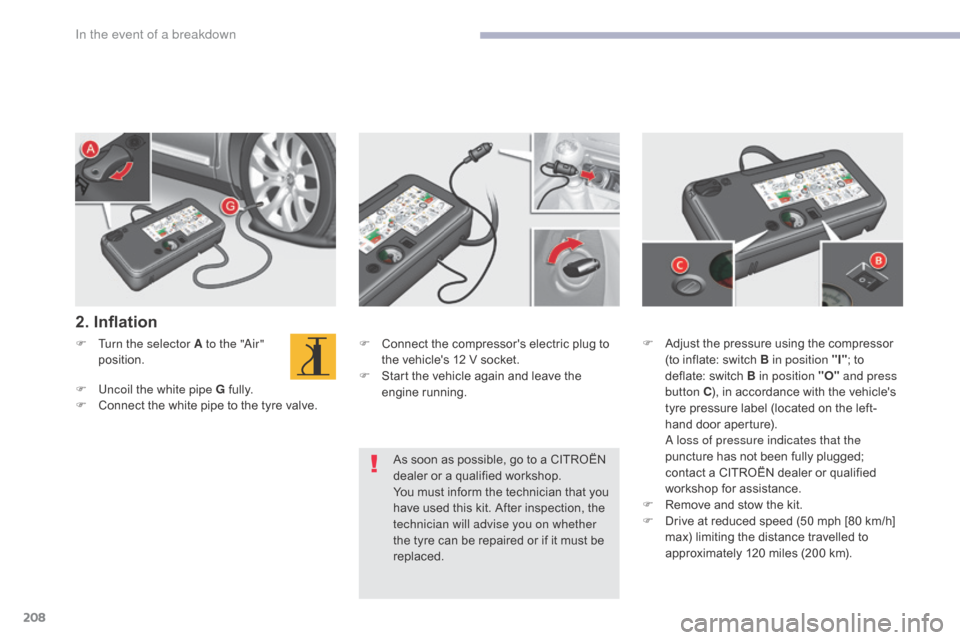
208
C5_en_Chap08_en-cas-de-panne_ed01-2016
2. Inflation
F Turn the selector A to the "Air" position.
F
U
ncoil the white pipe G fully.
F
C
onnect the white pipe to the tyre valve. F
C onnect the compressor's electric plug to
the vehicle's 12 V socket.
F
S
tart the vehicle again and leave the
engine running.
As soon as possible, go to a CITROËN
dealer or a qualified workshop.
You must inform the technician that you
have used this kit. After inspection, the
technician will advise you on whether
the tyre can be repaired or if it must be
replaced. F
A djust the pressure using the compressor
(to inflate: switch B in position "I" ; to
deflate: switch B in position "O" and press
button C ), in accordance with the vehicle's
tyre pressure label (located on the left-
hand door aperture).
A l
oss of pressure indicates that the
puncture has not been fully plugged;
contact a CITROËN dealer or qualified
workshop for assistance.
F
R
emove and stow the kit.
F
D
rive at reduced speed (50 mph [80 km/h]
max) limiting the distance travelled to
approximately 120 miles (200 km).
In the event of a breakdown
Page 212 of 348
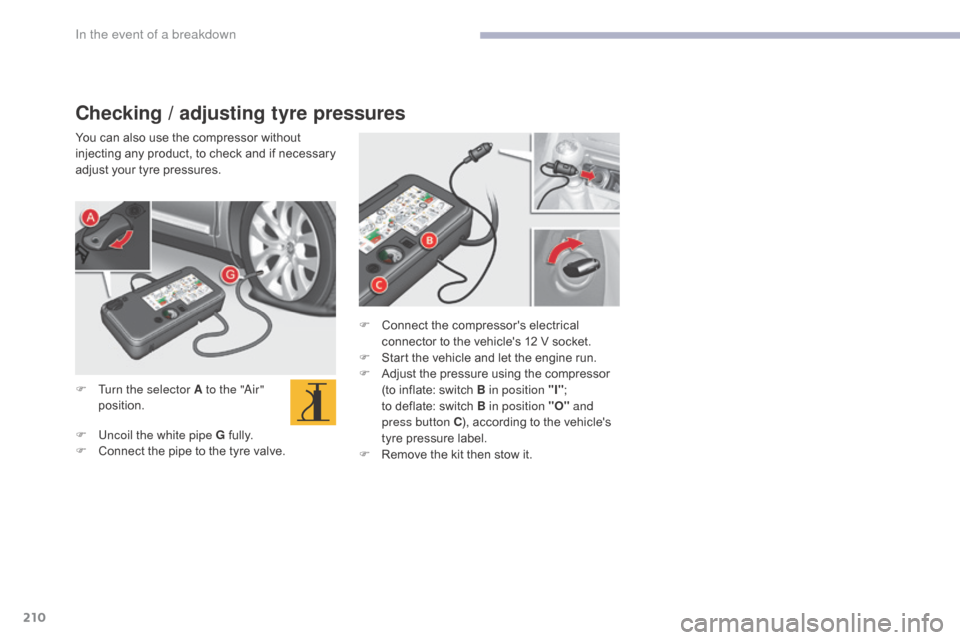
210
C5_en_Chap08_en-cas-de-panne_ed01-2016
Checking / adjusting tyre pressures
You can also use the compressor without
injecting any product, to check and if necessary
adjust your tyre pressures.
F
T
urn the selector A to the "Air"
position.
F
U
ncoil the white pipe G fully.
F
C
onnect the pipe to the tyre valve. F
C
onnect the compressor's electrical
connector to the vehicle's 12 V socket.
F
S
tart the vehicle and let the engine run.
F
A
djust the pressure using the compressor
(to inflate: switch B in position "I" ;
to
deflate: switch B in position "O" and
press button C ), according to the vehicle's
tyre pressure label.
F
R
emove the kit then stow it.
In the event of a breakdown
Page 213 of 348
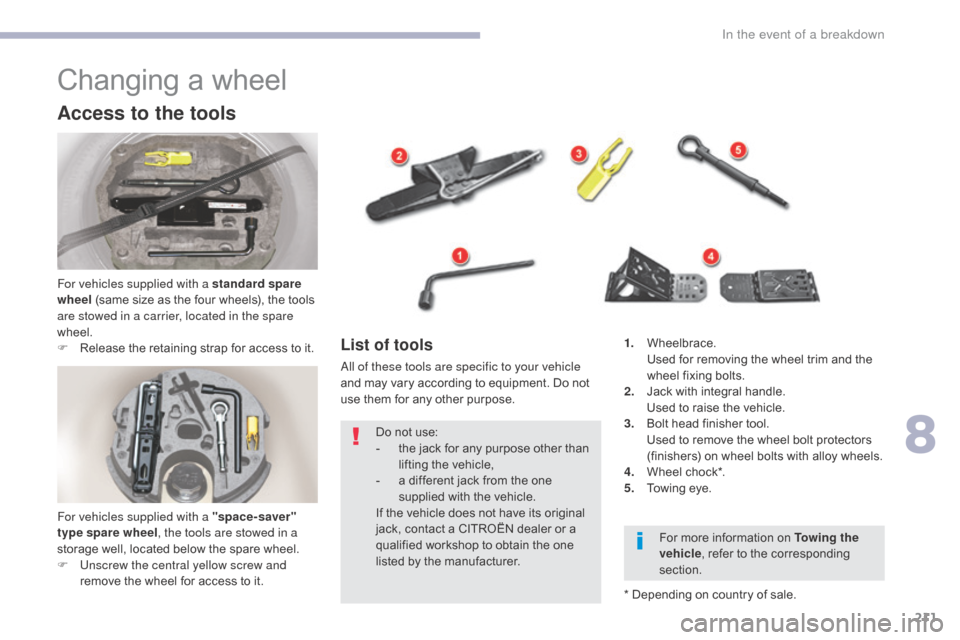
211
C5_en_Chap08_en-cas-de-panne_ed01-2016
Changing a wheel
Access to the tools
For vehicles supplied with a standard spare
wheel (same size as the four wheels), the tools
are stowed in a carrier, located in the spare
wheel.
F
R
elease the retaining strap for access to it.
List of tools
All of these tools are specific to your vehicle
and may vary according to equipment. Do not
use them for any other purpose. 1.
W
heelbrace. U
sed for removing the wheel trim and the
wheel fixing bolts.
2.
J
ack with integral handle.
U
sed to raise the vehicle.
3.
B
olt head finisher tool.
U
sed to remove the wheel bolt protectors
(finishers) on wheel bolts with alloy wheels.
4.
Wh
eel chock*.
5.
T
owing eye.
Do not use:
-
t
he jack for any purpose other than
lifting the vehicle,
-
a d
ifferent jack from the one
supplied with the vehicle.
If the vehicle does not have its original
jack, contact a CITROËN dealer or a
qualified workshop to obtain the one
listed by the manufacturer. For more information on Towing the
vehicle
, refer to the corresponding
section.
* Depending on country of sale.
For vehicles supplied with a "space-saver"
type spare wheel
, the tools are stowed in a
storage well, located below the spare wheel.
F
U
nscrew the central yellow screw and
remove the wheel for access to it.
8
In the event of a breakdown
Page 214 of 348

212
C5_en_Chap08_en-cas-de-panne_ed01-2016
Access to the spare wheel
Removing the boot floor
F Saloon: raise the boot floor and fold in two.
F T ourer : raise the boot floor and hook it
using the retractable handle. Secure the
hook to the top part of the boot.
Removing the standard spare
wheel
F Detach the strap, then push the wheel for wards so as to be able to lift it.
Repositioning the standard spare
wheel
F Position the spare wheel flat in the boot, then pull it towards you.
F
N
ext place the toolbox inside the wheel,
then secure the assembly using the strap.
Removing the "space-saver"
spare wheel
F Unscrew the central nut.
F R emove the fixing parts (nut and bolt).
F
T
ake the spare wheel from the rear and lift
it towards you.
F
R
emove the wheel from the boot.
In the event of a breakdown
Page 217 of 348
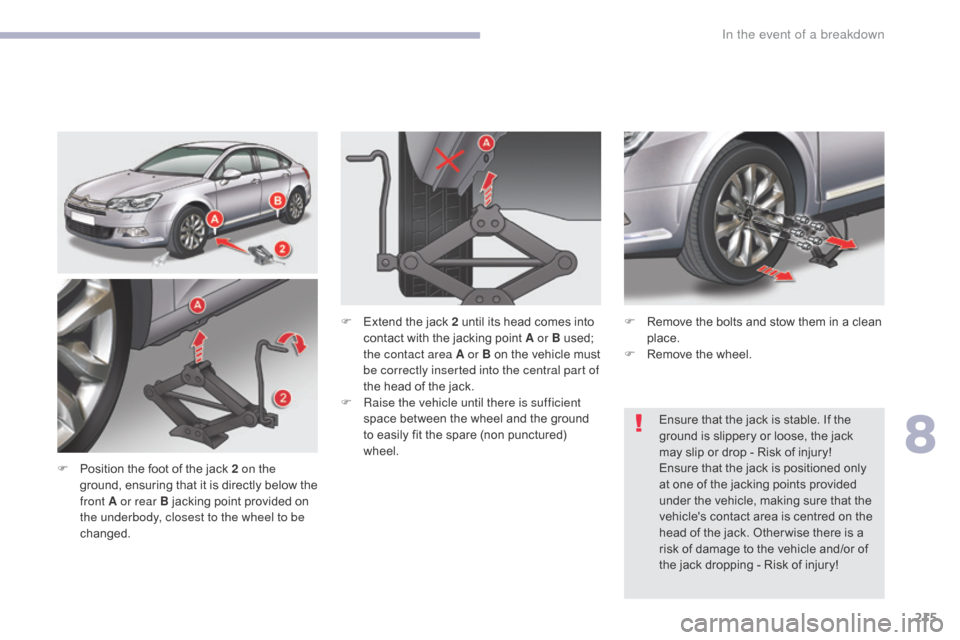
215
C5_en_Chap08_en-cas-de-panne_ed01-2016
F Position the foot of the jack 2 on the ground, ensuring that it is directly below the
front A or rear B jacking point provided on
the underbody, closest to the wheel to be
changed. Ensure that the jack is stable. If the
ground is slippery or loose, the jack
may slip or drop - Risk of injury!
Ensure that the jack is positioned only
at one of the jacking points provided
under the vehicle, making sure that the
vehicle's contact area is centred on the
head of the jack. Other wise there is a
risk of damage to the vehicle and/or of
the jack dropping - Risk of injury!
F
E
xtend the jack 2 until its head comes into
contact with the jacking point A or B used;
the contact area A or B on the vehicle must
be correctly inserted into the central part of
the head of the jack.
F
Ra
ise the vehicle until there is sufficient
space between the wheel and the ground
to easily fit the spare (non punctured)
wheel. F
R
emove the bolts and stow them in a clean
place.
F
R
emove the wheel.
8
In the event of a breakdown